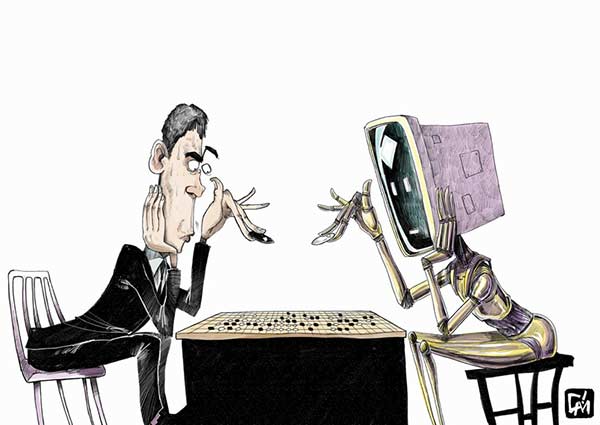How AI is changing how we do business: the father of contemporary AI gives his views
 |
|
Human vs AlphaGo. By Cai Meng. China Daily |
Started in the 1950's, Artificial Intelligence, or AI, has experienced several ups and downs until 2016, when AlphaGo (built by DeepMind, a Google company) defeated the world champion of Go and AI becomes popular in the general public again. The drives for AI's currently popularity are three important breakthroughs: supercomputer, big data, and machine learning algorithm.
How is and will AI be influencing the business world? The authors have interviewed Professor Jürgen Schmidhuber, the father of contemporary AI. Professor Jürgen Schmidhuber's lab created Long short-Term Memory (LSTM) deep learning algorithm in the 1990's, which greatly advanced the development of deep learning and AI. One of Professor Jürgen Schmidhuber's students co-founded DeepMind, one of them was the first employee of DeepMind, and one of them is the first author of DeepMind's recent paper in Nature. In 2014, Professor Jürgen Schmidhuber co-founded NNAISENSE (a company of Artificial General Intelligence similar to DeepMind). Artificial General Intelligence, also called Strong AI, is the final destination of AI development. Comparing to Weak AI, who only solves one specific aspect of problems, Strong AI refers to AIs that can solve problems in different area and that can think, decide and reflect like human being.
The application of deep learning algorithm
Professor Jürgen Schmidhuber says he is pleased to see that there are billions of users covered by the applications based on LSTM algorithm. The largest listed companies, Apple, Google, Microsoft and Amazon, are widely using LSTM algorithm to provide services. Since 2015, for example, LSTM algorithm has reduced 49% of errors in speech recognition and accelerated the functionality of Google speech recognition, which is being used in more than two billions of Android mobile phones around the world. In addition, LSTM algorithm has also increase the adequacy of Google Translate. IPhone, Alexa of Amazon, Baidu and Microsoft are all using LSTM algorithm now. Moreover, deep learning has broad applications in other systems, such as recognition of video and handwriting; control of robots; analysis of image; summary of documentation; running chatting robots and smart personal assistants; and prediction of diseases, user click rates, stock market and component failure in large factories. AI will also derive innumerable applications in healthcare, industry, finance and legal professions.
What industries will be restructured by AI
Professor Jürgen Schmidhuber says that, in the long run, AI will restructure all of the industries and sectors. So far, AI has been used in different fields of healthcare, finance, traditional sectors. Among them, advertising is perhaps the most obvious industry that already has been massively affected by pattern recognition on user data through Google, Baidu, Amazon, Alibaba, Facebook and Tencent.
Healthcare is one of the most important applications of deep learning through artificial neuralnetworks as well. The expenditure in healthcare represents 10% of the world's GDP, according to World Bank statistics, and at least 10% of which is for medical diagnosis such as cancer detection, plaque detection in arteries, X-ray analysis, etc. That is worth about 1'000 billion USD per year. Given this huge market, many startups are now focusing on improving diagnosis by AI, as well as established companies such as IBM & Google. Professor Jürgen Schmidhuber believes that partial automation of medical diagnosis will not only save billions of dollars, but also make expert diagnostics accessible to many who currently cannot afford it. Thanks to AI and deep learning and LSTM etc, people will live longer and healthier.
In 2012, Professor Jürgen Schmidhuber's team won the first place of a medical imaging competition through deep learning. The application was cancer detection in human tissue, and his lab's methods became over 1000 times faster than previous methods. At the time Professor Jürgen Schmidhuber's team (led by Dan Ciresan) won the contest, computing was still 10 times more expensive than it is today. In other words, the computing power is 10 times as much for the same price today, with 10 time's bigger neural networks (NNs), and 10 times more data. This trend has held since Konrad Zuse built the first working program-controlled computer between 1935 and 1941. Today, 75 years later, hardware is roughly a million billion times faster per unit price. Professor Jürgen Schmidhuber believes that it will be possible to have cheap devices with the raw computational power of a human brain in near future. In addition, all of medical diagnosis through NNs method will be superhuman, and law makers in many countries will make it mandatory.
NNAISENSE is an outgrowth of Professor Jürgen Schmidhuber's academic labs in Munich and in Switzerland. NNAISENSE is pronounced like "nascence," because it's about the “birth of a general purpose Neural Network-based Artificial Intelligence (NNAI). It has 5 co-founders (Professor Jürgen Schmidhuber , CEO Faustino Gomez, Jan Koutnik, Jonathan Masci, Bas Steunebrink, and myself), brilliant advisors (Sepp Hochreiter, Marcus Hutter, Jaan Tallinn), outstanding employees, and revenues through ongoing state-of-the-art applications in industry and finance”, as Professor Jürgen Schmidhuber explained. The five co-founders of NNAISENSE believe that the current commercial success of LSTM algorithm is just the beginning, and that they can go far beyond what's possible today, through novel variants of meta-learning, artificial curiosity and creativity, optimal program search and large reinforcement learning recurrent neural networks, to pull off the big practical breakthrough that will change everything. Professor Jürgen Schmidhuber says he believes that such an AGI will affect every business, and eventually transcend humankind.
Currently, the business model of NNAISENSE is cooperating with various industry partners, and designing solutions for them. And from each job, the neural network-based AI of NNAISENSE learns new skills, and to become a more and more general problem solver. NNAISENSE's destination is to create an AGI that continuously learn new skills on the bases of the existing skills, and that learn faster and faster. Some of those problem-solving skills will be created by AI itself through curiosity (Professor Jürgen Schmidhuber has proposed and developed the theory of AI curiosity and creativity since 1991).
Arcelor Mittal, the world's largest steel maker, worked with NNAISENSE to greatly improve steel defect detection. Cameras take pictures of the steel which is rapidly coming out of the steel mill.
NNs learned to do a better job, than the traditional approach did using humans, in identifying high-quality steel that can be sold for a higher price through patterns in the pictures. Such pattern recognition technology is applicable for thousands of industries.
NNAISENSE and Acatis, a German fund, co-founded Quantenstein. Quantenstein uses Machine Learning to pick stocks and manage portfolios. The new fund Quantenstein is about to launch aims at 3% outperformance w.r.t. MSCI world index, keeping comparable volatility. During walk forward testing, Quantenstein's new fund obtained approximately 5% outperformance (initial investment in Jan 2006), information ratio of 1.0 and performance p.a. of 12%. The main difference of Quantenstein to other funds is that no human in the loop, all AI-driven end-to-end. The AI receives fundamental data of companies, produces portfolios and weights, and adjusts portfolios regularly. Conventional systems for long-term value investing usually have a first stage where stocks are selected, followed by a second stage where Markowitz or other "crafted” methods are used to produce portfolio weights. Quantenstein's system learns also the second stage, given the optimization objectives such as high information ratio or Sharpe ratio. In addition to intelligent investment field, AI is also used in marketing and security of financial sector.
NNAISENSE recently worked with Volkswagen AG's Audi auto department to create a miniaturized car that learned to park itself without a teacher. The system used cameras to teach itself how to drive on its own. It different from others which imitate human teachers and rely on Lidar and radar to find their way around based on predetermined parameters.
Professor Jürgen Schmidhuber says that, ultimately, the mission of NNAISENSE is to create a general purpose AI that continually learns new skills on top of old skills, and even learns to learn new skills more quickly. On the way to reaching this goal, Professor Jürgen Schmidhuber's team is working on a variety of problems in partnership with industry that test different aspects of the system they are building, and provide essential insights that inform their on-going research plan. While finance and automotive do present different challenges, there are common underlying principles: both require learning to make predictions based on complex high-dimensional data, and learning to make the right decisions based on those predictions.
In the view of Professor Jürgen Schmidhuber, it is difficult to know exactly which industry will be the next to experience a similar change as advertisement industry. One reason is that AI is not an isolated technology, but affecting many other technologies that apply to different sectors with respective big data. In addition, there are all kinds of legal obstacles in many domains such as insurance, autonomous driving, privacy in health care and other fields.
Business model of AI development
Professor Jürgen Schmidhuber says that the Business to Business model is the right strategy for the sustainable development of a commercial intelligence. He also thinks that AI may become increasingly B2C as the ultimate goal is reached, but for its development, B2B provides some of the greatest opportunities because certain large entities possess both interesting proprietary data sets and challenging real-world control problems useful to convincingly validate the progress of AI.
The future of AI and robots
Kids and even certain little animals are still smarter than the best self-learning robots right now. But Professor Jürgen Schmidhuber says within not so many years, it will be possible to build an NN-based AI robot (an NNAI) that incrementally learns to become at least as smart as a little animal, that curiously, creatively and continually learn to plan, reason and decompose a wide variety of problems into quickly solvable (or solved) sub problems, in a very general way. Once animal-level AI has been achieved, the next step towards human-level AI may be small: it took billions of years to evolve smart animals, but only a few millions of years on top of that to evolve humans. Technological evolution is much faster than biological evolution, because dead ends are weeded out much faster. That is, once there is animal-level AI, a few years or decades later, human-level AI can be created, with truly limitless applications. At that time, “every business will change, all of civilization will change, and EVERYTHING will change” Professor Jürgen Schmidhuber concluded.
European academic labs still leads in AI R&D
Professor Jürgen Schmidhuber says that the next breakthroughs in AI technologies in the coming decade are not easily predictable, otherwise they would not be breakthroughs. Nevertheless, most of the fundamental breakthroughs in AI and NNs research occurred in the previous millennium in small academic (often European) labs, not in companies. As Professor Jürgen Schmidhuber predicts, it will stay like that. However, big American and Chinese companies have excelled at scaling things up in ways impossible for academic labs, and to roll this out for billions of users.
The advantages of AI in China
Professor Jürgen Schmidhuber says that he has observed rapid growth of AI-related sectors in China. There are outstanding talents, a lot of excitements about AI, deep learning and LSTM, and huge investments. He believes that China will play a very important role in the further development of AI. Meanwhile, he is sure that current development of AI is not a new bubble. On the contrary, it is only the beginning.
The authors are research fellows of Institute for Global Industry, Tsinghua University.






















